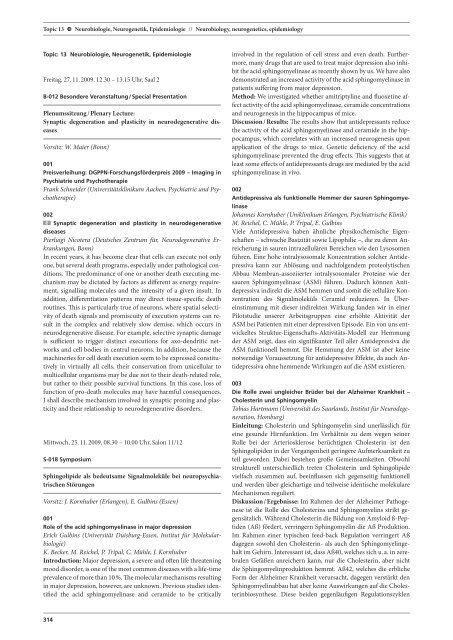Psychische Erkrankungen in der Lebensspanne ... - DGPPN
Psychische Erkrankungen in der Lebensspanne ... - DGPPN
Psychische Erkrankungen in der Lebensspanne ... - DGPPN
Sie wollen auch ein ePaper? Erhöhen Sie die Reichweite Ihrer Titel.
YUMPU macht aus Druck-PDFs automatisch weboptimierte ePaper, die Google liebt.
Topic 13 G Neurobiologie, Neurogenetik, Epidemiologie // Neurobiology, neurogenetics, epidemiology<br />
Topic: 13 Neurobiologie, Neurogenetik, Epidemiologie<br />
Freitag, 27. 11. 2009, 12.30 – 13.15 Uhr, Saal 2<br />
B-012 Beson<strong>der</strong>e Veranstaltung / Special Presentation<br />
Plenumssitzung / Plenary Lecture:<br />
Synaptic degeneration and plasticity <strong>in</strong> neuro degenerative diseases<br />
Vorsitz: W. Maier (Bonn)<br />
001<br />
Preisverleihung: <strong>DGPPN</strong>-Forschungsför<strong>der</strong>preis 2009 – Imag<strong>in</strong>g <strong>in</strong><br />
Psychiatrie und Psychotherapie<br />
Frank Schnei<strong>der</strong> (Universitätskl<strong>in</strong>ikum Aachen, Psychiatrie und Psychotherapie)<br />
002<br />
Synaptic degeneration and plasticity <strong>in</strong> neurodegenerative<br />
dis eases<br />
Pierluigi Nicotera (Deutsches Zentrum für, Neurodegenerative <strong>Erkrankungen</strong>,<br />
Bonn)<br />
In recent years, it has become clear that cells can execute not only<br />
one, but several death programs, especially un<strong>der</strong> pathological conditions.<br />
The predom<strong>in</strong>ance of one or another death execut<strong>in</strong>g mechanism<br />
may be dictated by factors as different as energy requirement,<br />
signall<strong>in</strong>g molecules and the <strong>in</strong>tensity of a given <strong>in</strong>sult. In<br />
addition, differentiation patterns may direct tissue-specific death<br />
rout<strong>in</strong>es. This is particularly true of neurons, where spatial selectivity<br />
of death signals and promiscuity of execution systems can result<br />
<strong>in</strong> the complex and relatively slow demise, which occurs <strong>in</strong><br />
neurodegenerative disease. For example, selective synaptic damage<br />
is sufficient to trigger dist<strong>in</strong>ct executions for axo-dendritic networks<br />
and cell bodies <strong>in</strong> central neurons. In addition, because the<br />
mach<strong>in</strong>eries for cell death execution seem to be expressed constitutively<br />
<strong>in</strong> virtually all cells, their conservation from unicellular to<br />
multicellular organisms may be due not to their death-related role,<br />
but rather to their possible survival functions. In this case, loss of<br />
function of pro-death molecules may have harmful consequences.<br />
I shall describe mechanism <strong>in</strong>volved <strong>in</strong> synaptic pron<strong>in</strong>g and plasticity<br />
and their relationship to neurodegenerative disor<strong>der</strong>s.<br />
Mittwoch, 25. 11. 2009, 08.30 – 10.00 Uhr, Salon 11/12<br />
S-018 Symposium<br />
Sph<strong>in</strong>golipide als bedeutsame Signalmoleküle bei neuropsychiatrischen<br />
Störungen<br />
Vorsitz: J. Kornhuber (Erlangen), E. Gulb<strong>in</strong>s (Essen)<br />
001<br />
Role of the acid sph<strong>in</strong>gomyel<strong>in</strong>ase <strong>in</strong> major depression<br />
Erich Gulb<strong>in</strong>s (Universität Duisburg-Essen, Institut für Molekularbiologie)<br />
K. Becker, M. Reichel, P. Tripal, C. Mühle, J. Kornhuber<br />
Introduction: Major depression, a severe and often life threaten<strong>in</strong>g<br />
mood disor<strong>der</strong>, is one of the most common diseases with a life-time<br />
prevalence of more than 10 %. The molecular mechanisms result<strong>in</strong>g<br />
<strong>in</strong> major depression, however, are unknown. Previous studies identified<br />
the acid sph<strong>in</strong>gomyel<strong>in</strong>ase and ceramide to be critically<br />
314<br />
<strong>in</strong>volv ed <strong>in</strong> the regulation of cell stress and even death. Furthermore,<br />
many drugs that are used to treat major depression also <strong>in</strong>hibit<br />
the acid sph<strong>in</strong>gomyel<strong>in</strong>ase as recently shown by us. We have also<br />
demonstrated an <strong>in</strong>creased activity of the acid sph<strong>in</strong>gomyel<strong>in</strong>ase <strong>in</strong><br />
patients suffer<strong>in</strong>g from major depression.<br />
Method: We <strong>in</strong>vestigated whether amitriptyl<strong>in</strong>e and fluoxet<strong>in</strong>e affect<br />
activity of the acid sph<strong>in</strong>gomyel<strong>in</strong>ase, ceramide concentrations<br />
and neurogenesis <strong>in</strong> the hippocampus of mice.<br />
Discussion / Results: The results show that antidepressants reduce<br />
the activity of the acid sph<strong>in</strong>gomyel<strong>in</strong>ase and ceramide <strong>in</strong> the hippocampus,<br />
which correlates with an <strong>in</strong>creased neurogenesis upon<br />
application of the drugs to mice. Genetic deficiency of the acid<br />
sph<strong>in</strong>gomyel<strong>in</strong>ase prevented the drug effects. This suggests that at<br />
least some effects of antidepressants drugs are mediated by the acid<br />
sph<strong>in</strong>gomyel<strong>in</strong>ase <strong>in</strong> vivo.<br />
002<br />
Antidepressiva als funktionelle Hemmer <strong>der</strong> sauren Sph<strong>in</strong>gomyel<strong>in</strong>ase<br />
Johannes Kornhuber (Unikl<strong>in</strong>ikum Erlangen, Psychiatrische Kl<strong>in</strong>ik)<br />
M. Reichel, C. Mühle, P. Tripal, E. Gulb<strong>in</strong>s<br />
Viele Antidepressiva haben ähnliche physikochemische Eigenschaften<br />
– schwache Basizität sowie Lipophilie –, die zu <strong>der</strong>en Anreicherung<br />
<strong>in</strong> sauren <strong>in</strong>trazellulären Bereichen wie den Lysosomen<br />
führen. E<strong>in</strong>e hohe <strong>in</strong>tralysosomale Konzentration solcher Antidepressiva<br />
kann zur Ablösung und nachfolgendem proteolytischen<br />
Abbau Membran-assoziierter <strong>in</strong>tralysosomaler Prote<strong>in</strong>e wie <strong>der</strong><br />
sauren Sph<strong>in</strong>gomyel<strong>in</strong>ase (ASM) führen. Dadurch können Antidepressiva<br />
<strong>in</strong>direkt die ASM hemmen und somit die zelluläre Konzentration<br />
des Signalmoleküls Ceramid reduzieren. In Übere<strong>in</strong>stimmung<br />
mit dieser <strong>in</strong>direkten Wirkung fanden wir <strong>in</strong> e<strong>in</strong>er<br />
Pilotstudie unserer Arbeitsgruppen e<strong>in</strong>e erhöhte Aktivität <strong>der</strong><br />
ASM bei Patienten mit e<strong>in</strong>er depressiven Episode. E<strong>in</strong> von uns entwickeltes<br />
Struktur-Eigenschafts-Aktivitäts-Modell zur Hemmung<br />
<strong>der</strong> ASM zeigt, dass e<strong>in</strong> signifikanter Teil aller Antidepressiva die<br />
ASM funktionell hemmt. Die Hemmung <strong>der</strong> ASM ist aber ke<strong>in</strong>e<br />
notwendige Voraussetzung für antidepressive Effekte, da auch Antidepressiva<br />
ohne hemmende Wirkungen auf die ASM existieren.<br />
003<br />
Die Rolle zwei ungleicher Brü<strong>der</strong> bei <strong>der</strong> Alzheimer Krankheit –<br />
Cholester<strong>in</strong> und Sph<strong>in</strong>gomyel<strong>in</strong><br />
Tobias Hartmann (Universität des Saarlands, Institut für Neurodegeneration,<br />
Homburg)<br />
E<strong>in</strong>leitung: Cholester<strong>in</strong> und Sph<strong>in</strong>gomyel<strong>in</strong> s<strong>in</strong>d unerlässlich für<br />
e<strong>in</strong>e gesunde Hirnfunktion. Im Verhältnis zu dem wegen se<strong>in</strong>er<br />
Rolle bei <strong>der</strong> Arteriosklerose berüchtigten Cholester<strong>in</strong> ist den<br />
Sph<strong>in</strong>golipiden <strong>in</strong> <strong>der</strong> Vergangenheit ger<strong>in</strong>gere Aufmerksamkeit zu<br />
teil geworden. Dabei bestehen große Geme<strong>in</strong>samkeiten. Obwohl<br />
strukturell unterschiedlich treten Cholester<strong>in</strong> und Sph<strong>in</strong>golipide<br />
vielfach zusammen auf, bee<strong>in</strong>flussen sich gegenseitig funktionell<br />
und werden über gleichartige und teilweise identische molekulare<br />
Mechanismen reguliert.<br />
Diskussion / Ergebnisse: Im Rahmen <strong>der</strong> <strong>der</strong> Alzheimer Pathogenese<br />
ist die Rolle des Cholester<strong>in</strong>s und Sph<strong>in</strong>gomyel<strong>in</strong>s strikt gegensätzlich.<br />
Während Cholester<strong>in</strong> die Bildung von Amyloid ß-Peptiden<br />
(Aß) för<strong>der</strong>t, verr<strong>in</strong>gern Sph<strong>in</strong>gomyel<strong>in</strong> die Aß Produktion.<br />
Im Rahmen e<strong>in</strong>er typischen feed-back Regulation verr<strong>in</strong>gert Aß<br />
dagegen sowohl den Cholester<strong>in</strong>- als auch den Sph<strong>in</strong>gomyel<strong>in</strong>gehalt<br />
im Gehirn. Interessant ist, dass Aß40, welches sich u. a. <strong>in</strong> zerebralen<br />
Gefäßen anreichern kann, nur die Cholester<strong>in</strong>, aber nicht<br />
die Sph<strong>in</strong>gomyel<strong>in</strong>produktion hemmt. Aß42, welches die erbliche<br />
Form <strong>der</strong> Alzheimer Krankheit verursacht, dagegen verstärkt den<br />
Sph<strong>in</strong>gomyel<strong>in</strong>abbau hat aber ke<strong>in</strong>e Auswirkungen auf die Cholester<strong>in</strong>biosynthese.<br />
Diese beiden gegenläufigen Regulationszyklen


